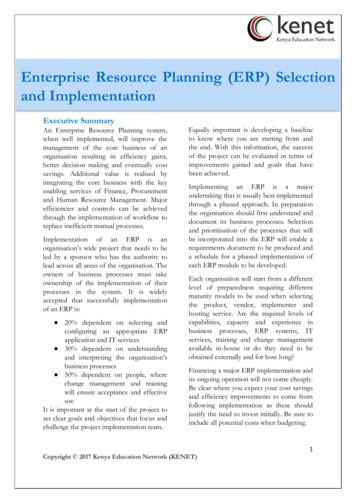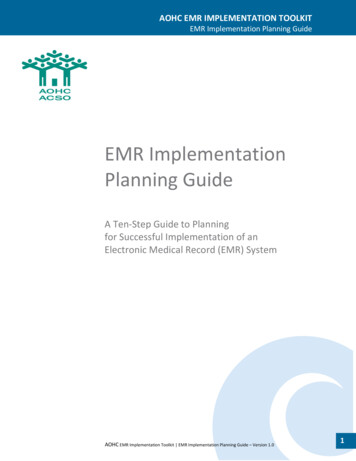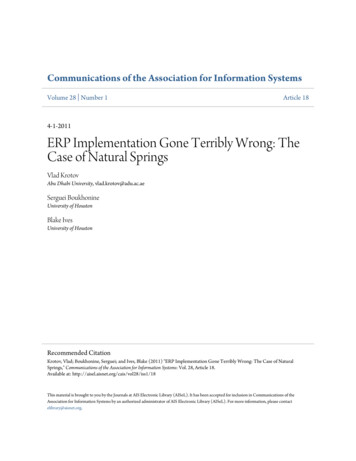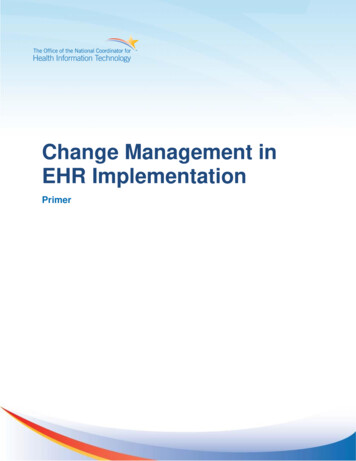
Transcription
Enterprise Resource Planning (ERP) Selectionand ImplementationExecutive SummaryAn Enterprise Resource Planning system,when well implemented, will improve themanagement of the core business of anorganisation resulting in efficiency gains,better decision making and eventually costsavings. Additional value is realised byintegrating the core business with the keyenabling services of Finance, Procurementand Human Resource Management. Majorefficiencies and controls can be achievedthrough the implementation of workflow toreplace inefficient manual processes.Implementation of an ERP is anorganisation’s wide project that needs to beled by a sponsor who has the authority tolead across all areas of the organisation. Theowners of business processes must takeownership of the implementation of theirprocesses in the system. It is widelyaccepted that successfully implementationof an ERP is: 20% dependent on selecting andconfiguring an appropriate ERPapplication and IT services 30% dependent on understandingand interpreting the organisation’sbusiness processes 50% dependent on people, wherechange management and trainingwill ensure acceptance and effectiveuseIt is important at the start of the project toset clear goals and objectives that focus andchallenge the project implementation team.Equally important is developing a baselineto know where you are starting from andthe end. With this information, the successof the project can be evaluated in terms ofimprovements gained and goals that havebeen achieved.Implementing an ERP is a majorundertaking that is usually best implementedthrough a phased approach. In preparationthe organisation should first understand anddocument its business processes. Selectionand prioritisation of the processes that willbe incorporated into the ERP will enable arequirements document to be produced anda schedule for a phased implementation ofeach ERP module to be developed.Each organisation will start from a differentlevel of preparedness requiring differentmaturity models to be used when selectingthe product, vendor, implementer andhosting service. Are the required levels ofcapabilities, capacity and experience inbusiness processes, ERP systems, ITservices, training and change managementavailable in-house or do they need to beobtained externally and for how long?Financing a major ERP implementation andits ongoing operation will not come cheaply.Be clear where you expect your cost savingsand efficiency improvements to come fromfollowing implementation as these shouldjustify the need to invest initially. Be sure toinclude all potential costs when budgeting.1Copyright 2017 Kenya Education Network (KENET)
The cost of the ERP application is usually arelatively small percentage compared to thetotal cost that will include:service for the ERP application in their datacentres or make arrangements for hosting inMicrosoft Azure. the cost of consultants and stafftime during the implementation; IT servers for live and developmentenvironments and possible ITinfrastructure improvements; and Change management,communication and training costsshould not be underestimated orundervalued.Following implementation, the operatingcosts will include:Major benefits can be realised if memberorganisations collaborate through KENET.This can involve negotiating volumediscounts from vendors for aggregatelicense numbers based on all organisationsthat plan to implement the same product.Searching and negotiating for fundingopportunities on behalf of members. ERP application updates, upgradesand support from the vendor the IT infrastructure operation internal support to the users continual improvements by aninternal team or with externalassistanceThere are a myriad of pricing structures andoptions available from the vendors thatneed to match your funding model. If youhave capital funds to invest then a phasedscheduled payment for licenses can beconsidered. If you have operating funds, forexample a cost recovery model from studentfees, then a consistently priced subscriptionmodel may be more appropriate.KENET will assist in many ways butultimately, the responsibility for decisionmaking for an ERP implementation lies withthe member organisation. KENET canprovide guidance, examples and templatesfor best practices during the preparation ofan ERP project. Market intelligence on theglobal and local vendors in the sector will beobtained and shared with members, alongwith references and lessons learnt frommembers that have experience with ERPimplementation and operations. KENETcan also provide a secure managed hostingIf members from the same sector cometogether and agree on a common productand implementation design with minor localconfigurations, it opens up opportunities fora single ERP design template to beimplemented quickly throughout the sectorusing shared testing and training materialsand support.Where a business need exists from itsmembers KENET can evaluate therequirements and propose to expand itscapabilities and capacity to meet the needsof its members.1. IntroductionImplementing an ERP System is a majorundertaking as it affects all aspects of anorganisation’s work. An ERP can be definedin many different ways, in this document itrefers to an IT application that can be usedto manage the organisation’s core businessand incorporating the supporting services ofFinance,HumanResourcesandProcurement.One product may not be able to providethe “best in class” solutions for allimportant business processes, in which caseproducts can be integrated to create aseamless system. The objective of bringingbusiness processes into one system is to2Copyright 2017 Kenya Education Network (KENET)
provide more effective and efficient servicesto the customers whileimproving the organisation’s analytical anddecision-making capabilities and eventuallyreducing costs.This document aims to provide a briefoverview of the steps involved in selectingand implementing an ERP system. Furtherdetails will be made available in associateddocuments.2. Objectives and preparationsAt the start of the project it is important toset the objectives for the ERPimplementation. Why is the organisationtaking on the project? Some commonreasons include: Improved efficiency leading to costssavings More effective use of resources Improved data and analysis leadingto better decision making Replacement of outdated orincomplete systemsA realistic budget and timeline for theimplementation should be set and can berefined when the full scope of the project isfinalised. The organisation will use theobjectives as one of the measures of successat the end of the project. It is thereforeimportant to prepare baseline informationthat can be used for comparison. Where istheorganisationstartingfrom?3. Implementation TeamAll major projects have an implementation team to provide oversight and carry out theimplementation of the project. An ERP implementation will affect the core business and allassociated supporting services. Figure 1 provides a suggested structure for the implementationteam for an ERP implementation.Figure1: An example structure of an ERP Project implementation teamThe tasks expected of the implementation team and the definition of the roles of importantindividuals in the structure are provided in Annex 1. Members of the implementation team may3Copyright 2017 Kenya Education Network (KENET)
not be able to perform all their normal duties at this time and alternativearrangement should be made to spread the workload.4. Document Current WorkProcesses and FutureExpectationsBefore starting on the implementation of anERP project, the organisation needs toknow exactly what work is done in theorganisation and how it is carried out. Aclear picture of an organisation can beobtained by documenting the workprocesses carried out by each business unitwithin the organisation.The ERP should enable an organisation todo more than they currently do with theirexisting systems. List any additional workprocesses that you expect to be able to carryout if working more efficiently. What are thetype of reports and analysis that managerswant to see in future to aid them in theirdecision making? If these can be defined atan early stage in the implementationprocess, it will ensure that the data requiredto produce this information is included inthe ERP system.5. Decide on the scope of theERP implementationBefore starting the selection process, a clearroadmap of which work processes theorganisations wants to include in the ERPsystem should be developed. It may be moreefficient to continue to carry out some workprocesses manually especially if they addlittle value when integrated with the otherwork processes. Some processes may bevery specialised in nature and require theirown specialised application that can beintegrated with the ERP.go live. Therefore, many organisationsdecide on a phased implementation tospread the workload over a longer period.In this case the work processes should beprioritised so that the order ofimplementation can be determined.Remember that an ERP should evolvearound the core business of theorganisation, for KENET members this isEducation and Research. The ent will add value to thecore business in an ERP implementation.6. Create a RequirementsDocumentOnce the scope of the ERP implementationis clear, a detailed requirements documentneeds to be developed. The requirementsdocument will form the most importantsection in the Request for Proposal (RFP)that vendors will use to prepare theirresponses and the organisation will use toevaluate the submitted proposals. Therequirements document will also be used asa baseline which the success of theimplementation will be measured against.7. Select Product, Vendor andImplementerThe procurement process of theorganisation will follow, and it will mostlikely be a tender process. Some informationand tips to guide an organisation in theselection process:The work involved in implementing an ERPcan be immense, especially the amount ofchange management and training required at Ensure the product meets therequirements, don’t rely 100% onthe vendor’s word as they want mostof all to sell their product. Obtainboth formal and informal references2Copyright 2017 Kenya Education Network (KENET)
from trusted sources to find out anyshortcomings of the product. Negotiate the price down as low aspossible, prices of ERP products arenot fixed and the lower the purchaseprice, the lower the annualmaintenance fee is likely to be as it isoften a fixed percentage of thepurchase price. Who will implement the ERP? Theorganisation is unlikely to have therequiredtechnicalskillstoimplement a new product s an ERP.The costof consultancy for implementation islikely to be more that the cost of theapplication. Are there enoughspecialised consultants available towork on the project? Will theconsultants build up the expertise ofthe internal staff or keep theknowledge to themselves? Who will host and manage theimplementation and operation of theERP infrastructure? Are theresources and skills available inhouse? Does the vendor provide acloud-based solution allowing theorganisation to concentrate onimplementation and operation of theapplication? Are there 3rd partyservice providers thatwillprovide a managed hosting servicefor theimplementation and operation of theERP (possibly KENET)?8. Steps .108.118.128.13inERPBaseline review for comparisonwith future evaluationSystem Design Document (SDD)and BlueprintBuild/configuration documentsData migration plan3rd party application integrationplanTraining plan and trainingmaterialsChange management planTest scripts based on businessprocessesBuild/Configure the ERP systemCarry out integrated system testingCarry out User AcceptanceTesting (UAT)Carry out End User Training(EUT)Post implementation review andevaluationSomeone once said an ERP implementation is never complete as there will always be additionalfunctions to be implemented and improvements to be made. It is therefore important tocontinue to plan for each phase of the implementation so that there is a clear start and end to thecontinuous improvement of projects.Annex 1: Details Related to the Implementation TeamThe Steering Committee and Executive Sponsors are responsible for the oversight of the project,making decisions to ensure the project meets its goals. Pro Project Management is responsiblefor the day to day tasks of implementing the project and ensuring that the Steering Committee’s3Copyright 2017 Kenya Education Network (KENET)
decisions are implemented. Quality Assurance of the project should be providedby agroup that is independent of the project implementation. In this example the Internal Audit unitprovided quality control.Business Unit teams take responsibility for the implementation of the ERP modules that have asignificant impact on their unit. In this example Research Projects (Project team) is the corebusiness of the organisation and should be changed to reflect the core business of theimplementing organisation. Add any additional Business Unit teams that will play a significantrole in the project implementation.Important Roles in the Project Executive project sponsorProject managerProcess ownersKey business usersEnd usersExecutive SponsorThe executive sponsor is responsible to their organisation for the success of the project. Theperson in this role rarely becomes involved in the running of the project. The executivesponsor’s role centres around: Advocating the project both internally and externallyChampioning the projectObtaining budgets for the projectAccepting responsibility for problems escalated from the project managerSigning off documents such as the business case and project initiation documentSupporting the project manager in managing the projectThe executive sponsor often needs to be able to exert pressure within the organisation toovercome resistance to the project. For this reason, the executive sponsor will ideally be a personwith great executive/political authority and natural authority.Project Manager (Team Leader)The project manager will take the overall responsibility for the successful planning, execution,monitoring, control and closure of the implementation. A project manager must be in a positionto dedicate the majority of their time (or full time) for the duration of implementation.4Copyright 2017 Kenya Education Network (KENET)
Implementation Team – Super UsersTeam members will be individually focused on specific facets of the RP application. Typically,there will be one or more members to represent the core business, Finance, HR and IT andChange Management. The team will assist the vendor to implement the project and will in timebecome super users of the application, able to replace the functions originally carried out bymembers of the vendor’s implementation team.Key Business UsersOrganisations must identify and draw on the knowledge of their key business users. These areindividuals who have specialized knowledge of the key business processes of the organisation,and have the experience to understand that these strategies can be adapted at the time ofimplementation to encompass the best business practices inherent within the software. The keybusiness users will advise the implementation team on process requirements and will ensure thatthe configured software supports these.All UsersThe transition to a new system will affect all users and so it must be configured to support theappropriate user profiles. Organisations must identify who the users will be, what they will bedoing and assess their training requirements.Change Management StrategyThe change management team are responsible for developing and implementing the followingstrategic plans for the project: Change management Communication TrainingManaging change successfully is one of the prime factors in ensuring successful implementationof new software. Organisations should address this with a clear change management strategy thatensures that staff are supported through the changes that the new system will bring. Resistanceto change is a natural trait and the centres must do all they can to communicate with staff andhelp overcome resistance. Change must involve the people, change must not be imposed uponpeople. The following reference provides a wealth of useful information on the management ofchange http://www.businessballs.com/changemanagement.htm including:Change Management Principles1. At all times involve and accept support from people within the system (system environment, processes, culture, relationships, behaviours, etc., whether personal ororganisational).2. Understand where you/the organisation is at the moment.3. Understand where you want to be, when, why, and what the measures will be forhaving got there.4. Plan development towards above No.3 in appropriate achievable measurable stages.5. Communicate, involve, enable and facilitate involvement from people, as early andopenly and as fully as is possible.2Copyright 2017 Kenya Education Network (KENET)
Steps to Successful Change1. Increase urgency - inspire people to move, make objectives real and relevant.2. Build the guiding team - get the right people in place with the right emotionalcommitment, and the right mix of skills and levels.3. Get the vision right - get the team to establish a simple vision and strategy, focus onemotional and creative aspects necessary to drive service and efficiency.4. Communicate for buy-in - Involve as many people as possible, communicate theessentials, simply, and to appeal and respond to people's needs.5. De-clutter communications - make technology work for you rather than against.6. Empower action - Remove obstacles, enable constructive feedback and lots ofsupport from leaders - reward and recognise progress and achievements.7. Create short-term wins - Set aims that are easy to achieve - in bite-size chunks.Manageable numbers of initiatives. Finish current stages before starting new ones.8. Don't let up - Foster and encourage determination and persistence - ongoing change- encourage ongoing progress reporting - highlight achieved and future milestones.9. Make change stick - Reinforce the value of successful change via recruitment,promotion, new change leaders. Weave change into culture.Change Management TeamThe centre should identify a cross discipline team of change leaders to determine and deliver thechange management processes to ensure successful management of change.2Copyright 2017 Kenya Education Network (KENET)
an ERP project. Market intelligence on the global and local vendors in the sector will be obtained and shared with members, along with references and lessons learnt from members that have experience with ERP implementation and operations. KENET can also provide a secure managed hosting service for the ERP application in their data










